Data-Driven Contact-Based Thermosensation for Enhanced Tactile Recognition
Abstract
1. Introduction
2. Contact-Based Thermosensation Design
2.1. Design of the Measurement System Structure
2.2. Discrete Transient Heat Transfer Model
2.3. Finite Element Simulation
3. Data-Driven Algorithm
3.1. BP Neural Network
3.2. Data Set and NN Training
- Feature extraction. To fully describe the characteristics of heat flux and temperature signals, the linear fitting slope of the heat flux relative to its initial value and the linear fitting slope of the temperature series were calculated, denoted as u1 and u2, respectively. The average heat flux and average temperature were calculated as u3 and u4. The final time’s excess temperature; the midpoint’s excess temperature; the temperature difference between the midpoint and final time; and the difference in heat flux are also calculated, respectively noted as u5, u6, u7, and u8.
- Normalization. The dataset covered materials ranging from low to high thermal conductivity, with corresponding heat flux and temperature data showing significant variations. Therefore, the data features were first natural log-transformed, then normalized and denoted as X = norm(ln(u)), resulting in X = [x1, x2, x3, x4, x5, x6, x7, x8].
- Principal component analysis (PCA). PCA is a data analysis technique that can retain as much of the original features as possible while reducing data dimensions [33,34]. By processing data with PCA dimensionality reduction, the principal components obtained were denoted as p1 to p8. The contribution rates of p1 and p2 exceeded 95%, indicating that p1 and p2 can explain over 95% of the variance in the original data, thus effectively representing the original feature. The relationship between p1, p2, and the original features is as follows:
- With p1 and p2 as inputs and the thermal conductivity ko as output, a double hidden layer nonlinear mapping network was trained using a BP neural network. In this network, the number of neurons in the input layer was 2, the first hidden layer contained 100 neurons, the second hidden layer contained 20 neurons, and the output layer contained one neuron. The tansig function was used as the activation function for the hidden layers.
3.3. BP NN with Heat Transfer Model
4. Experiment
4.1. Samples of Tested Materials
4.2. Experimental Measurement System
5. Results and Discussion
6. Conclusions
Author Contributions
Funding
Institutional Review Board Statement
Informed Consent Statement
Data Availability Statement
Conflicts of Interest
References
- Shi, J.; Dai, Y.; Cheng, Y.; Xie, S.; Li, G.; Liu, Y.; Wang, J.; Zhang, R.; Bai, N.; Cai, M.; et al. Embedment of sensing elements for robust, highly sensitive, and cross-talk–free iontronic skins for robotics applications. Sci. Adv. 2023, 9, eadf8831. [Google Scholar] [CrossRef]
- Yuan, Z.; Shen, G.; Pan, C.; Wang, Z.L. Flexible sliding sensor for simultaneous monitoring deformation and displacement on a robotic hand/arm. Nano Energy 2020, 73, 104764. [Google Scholar] [CrossRef]
- Zhao, S.; Zhu, R. Electronic skin with multifunction sensors based on thermosensation. Adv. Mater. 2017, 29, 1606151. [Google Scholar] [CrossRef]
- Jones, L.A.; Ho, H.N. Warm or Cool, Large or Small? The Challenge of Thermal Displays. IEEE Trans. Haptics 2008, 1, 53–70. [Google Scholar] [CrossRef] [PubMed]
- Tadesse, M.G.; Loghin, E.; Pislaru, M.; Wang, L.; Chen, Y.; Nierstrasz, V.; Loghin, C. Prediction of the Tactile Comfort of Fabrics from Functional Finishing Parameters Using Fuzzy Logic and Artificial Neural Network Models. Text. Res. J. 2019, 89, 4083–4094. [Google Scholar] [CrossRef]
- Xiong, W.; Feng, H.; Liwang, H.; Li, D.; Yao, W.; Duolikun, D.; Zhou, Y.; Huang, Y.A. Multifunctional tactile feedbacks towards compliant robot manipulations via 3D-shaped electronic skin. IEEE Sens. J. 2022, 22, 9046–9056. [Google Scholar] [CrossRef]
- Li, G.; Liu, S.; Mao, Q.; Zhu, R. Multifunctional electronic skins enable robots to safely and dexterously interact with human. Adv. Sci. 2022, 9, 2104969. [Google Scholar] [CrossRef]
- Choi, C.; Ma, Y.; Li, X.; Chatterjee, S.; Sequeira, S.; Friesen, R.F.; Felts, J.R.; Hipwell, M.C. Surface haptic rendering of virtual shapes through change in surface temperature. Sci. Robot. 2022, 7, eabl4543. [Google Scholar] [CrossRef]
- Zhao, Y.; Bergmann, J.H.M. Non-Contact Infrared Thermometers and Thermal Scanners for Human Body Temperature Monitoring: A Systematic Review. Sensors 2023, 23, 7439. [Google Scholar] [CrossRef]
- Zhao, D.; Qian, X.; Gu, X.; Jajja, S.A.; Yang, R. Measurement techniques for thermal conductivity and interfacial thermal conductance of bulk and thin film materials. J. Electron. Packag. 2016, 138, 040802. [Google Scholar] [CrossRef]
- Pope, A.L.; Zawilski, B.; Tritt, T.M. Description of removable sample mount apparatus for rapid thermal conductivity measurements. Cryogenics 2001, 41, 725–731. [Google Scholar] [CrossRef]
- Tritt, T.M.; Weston, D. Measurement techniques and considerations for determining thermal conductivity of bulk materials. In Thermal Conductivity: Theory, Properties, and Applications; Springer: Boston, MA, USA, 2004; pp. 187–203. [Google Scholar]
- Dasgupta, T.; Umarji, A.M. Thermal properties of MoSi2 with minor aluminum substitutions. Intermetallics 2007, 15, 128–132. [Google Scholar] [CrossRef]
- Abu-Hamdeh, N.H.; Khdair, A.I.; Reeder, R.C. A comparison of two methods used to evaluate thermal conductivity for some soils. Int. J. Heat Mass Transf. 2001, 44, 1073–1078. [Google Scholar] [CrossRef]
- Breuer, S.; Schilling, F.R. Improving thermal diffusivity measurements by including detector inherent delayed response in laser flash method. Int. J. Thermophys. 2019, 40, 95. [Google Scholar] [CrossRef]
- Gustafsson, S.E. Transient plane source techniques for thermal conductivity and thermal diffusivity measurements of solid materials. Rev. Sci. Instrum. 1991, 62, 797–804. [Google Scholar] [CrossRef]
- Maeda, Y.; Maeda, K.; Kobara, H.; Mori, H.; Takao, H. Integrated pressure and temperature sensor with high immunity against external disturbance for flexible endoscope operation. Jpn. J. Appl. Phys. 2017, 56, 04CF09. [Google Scholar] [CrossRef]
- Basov, M. Schottky diode temperature sensor for pressure sensor. Sens. Actuators A Phys. 2021, 331, 112930. [Google Scholar] [CrossRef]
- Labrado, C.; Thapliyal, H.; Prowell, S.; Kuruganti, T. Use of thermistor temperature sensors for cyber-physical system security. Sensors 2019, 19, 3905. [Google Scholar] [CrossRef]
- Zhao, S.; Zhu, R. A smart artificial finger with multisensations of matter, temperature, and proximity. Adv. Mater. Technol. 2018, 3, 1800056. [Google Scholar] [CrossRef]
- Li, G.; Liu, S.; Wang, L.; Zhu, R. Skin-inspired quadruple tactile sensors integrated on a robot hand enable object recognition. Sci. Robot. 2020, 5, eabc8134. [Google Scholar] [CrossRef]
- Yang, W.; Xie, M.; Zhang, X.; Sun, X.; Zhou, C.; Chang, Y.; Zhang, H.; Duan, X. Multifunctional soft robotic finger based on a nanoscale flexible temperature–pressure tactile sensor for material recognition. ACS Appl. Mater. Interfaces 2021, 13, 55756–55765. [Google Scholar] [CrossRef] [PubMed]
- Lee, Y.; Park, J.; Choe, A.; Shin, Y.E.; Kim, J.; Myoung, J.; Lee, S.; Lee, Y.; Kim, Y.K.; Yi, S.W.; et al. Flexible pyroresistive graphene composites for artificial thermosensation differentiating materials and solvent types. ACS Nano 2022, 16, 1208–1219. [Google Scholar] [CrossRef] [PubMed]
- Wu, S.; Yang, J.; Xing, J.; Yu, J.; Zhang, K. An in-situ integrated material distinction sensor based on density and heat capacity. J. Phys. D Appl. Phys. 2023, 56, 455103. [Google Scholar] [CrossRef]
- Zhang, N.; Zou, H.; Zhang, L.; Puppala, A.J.; Liu, S.; Cai, G. A unified soil thermal conductivity model based on artificial neural network. Int. J. Therm. Sci. 2020, 155, 106414. [Google Scholar] [CrossRef]
- Fidan, S.; Oktay, H.; Polat, S.; Ozturk, S. An artificial neural network model to predict the thermal properties of concrete using different neurons and activation functions. Adv. Mater. Sci. Eng. 2019, 2019, 3831813. [Google Scholar] [CrossRef]
- Pan, B.; Zhu, D.; Zhang, M. Quantitative thermosensation in a single touch. Sens. Actuators A Phys. 2021, 321, 112584. [Google Scholar] [CrossRef]
- Zhang, N.; Ma, Y.; Zhang, Q. Prediction of sea ice evolution in Liaodong Bay based on a back-propagation neural network model. Cold Reg. Sci. Technol. 2018, 145, 65–75. [Google Scholar] [CrossRef]
- Li, X.; Xiang, S.; Zhu, P.; Wu, M. Establishing a dynamic self-adaptation learning algorithm of the BP neural network and its applications. Int. J. Bifurc. Chaos 2015, 25, 1540030. [Google Scholar] [CrossRef]
- Cao, H.; Cui, R.; Liu, W.; Ma, T.; Zhang, Z.; Shen, C.; Shi, Y. Dual mass MEMS gyroscope temperature drift compensation based on TFPF-MEA-BP algorithm. Sensor Rev. 2021, 41, 162–175. [Google Scholar] [CrossRef]
- Guiatni, M.; Kheddar, A. Theoretical and experimental study of a heat transfer model for thermal feedback in virtual environments. In Proceedings of the 2008 IEEE/RSJ International Conference on Intelligent Robots and Systems, Nice, France, 22–26 September 2008; pp. 2996–3001. [Google Scholar]
- Tan, Z.; Guo, G. Thermophysical Properties of Engineering Alloys; Metallurgical Industry Press: Beijing, China, 1994. [Google Scholar]
- Wold, S.; Esbensen, K.; Geladi, P. Principal component analysis. Chemom. Intell. Lab. Syst. 1987, 2, 37–52. [Google Scholar] [CrossRef]
- Webb, R.C.; Pielak, R.M.; Bastien, P.; Ayers, J.; Niittynen, J.; Kurniawan, J.; Manco, M.; Lin, A.; Cho, N.H.; Malyrchuk, V.; et al. Thermal transport characteristics of human skin measured in vivo using ultrathin conformal arrays of thermal sensors and actuators. PLoS ONE 2015, 10, e0118131. [Google Scholar] [CrossRef] [PubMed]


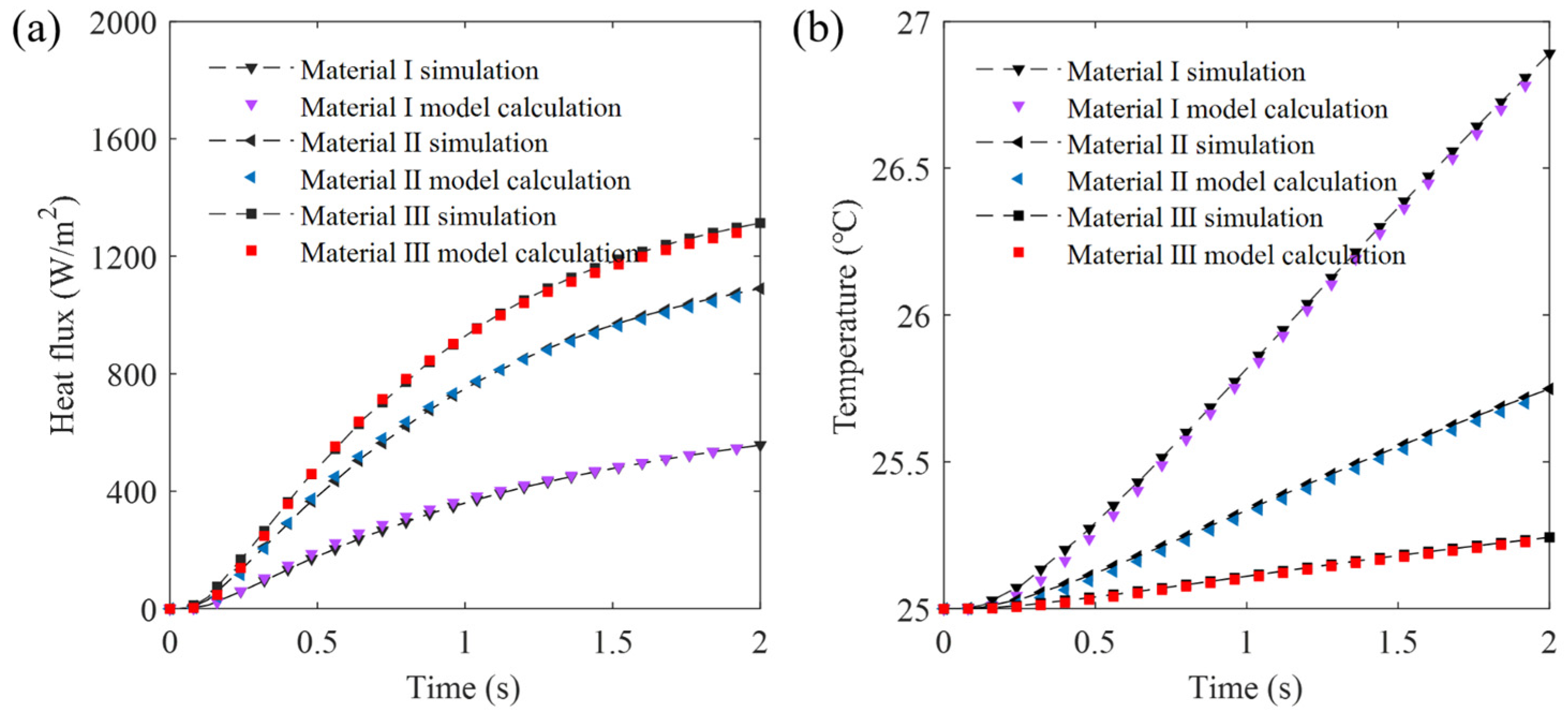


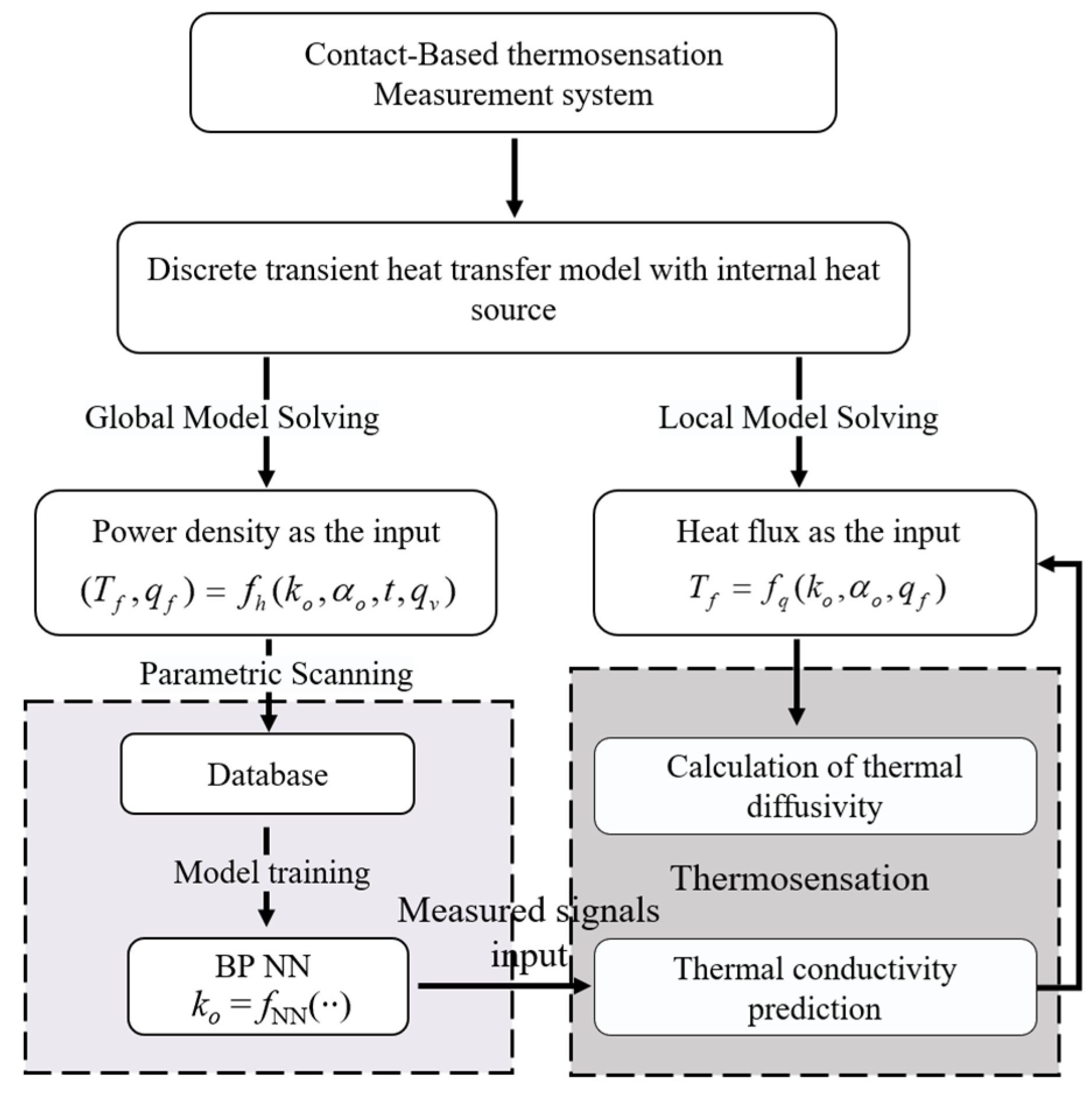

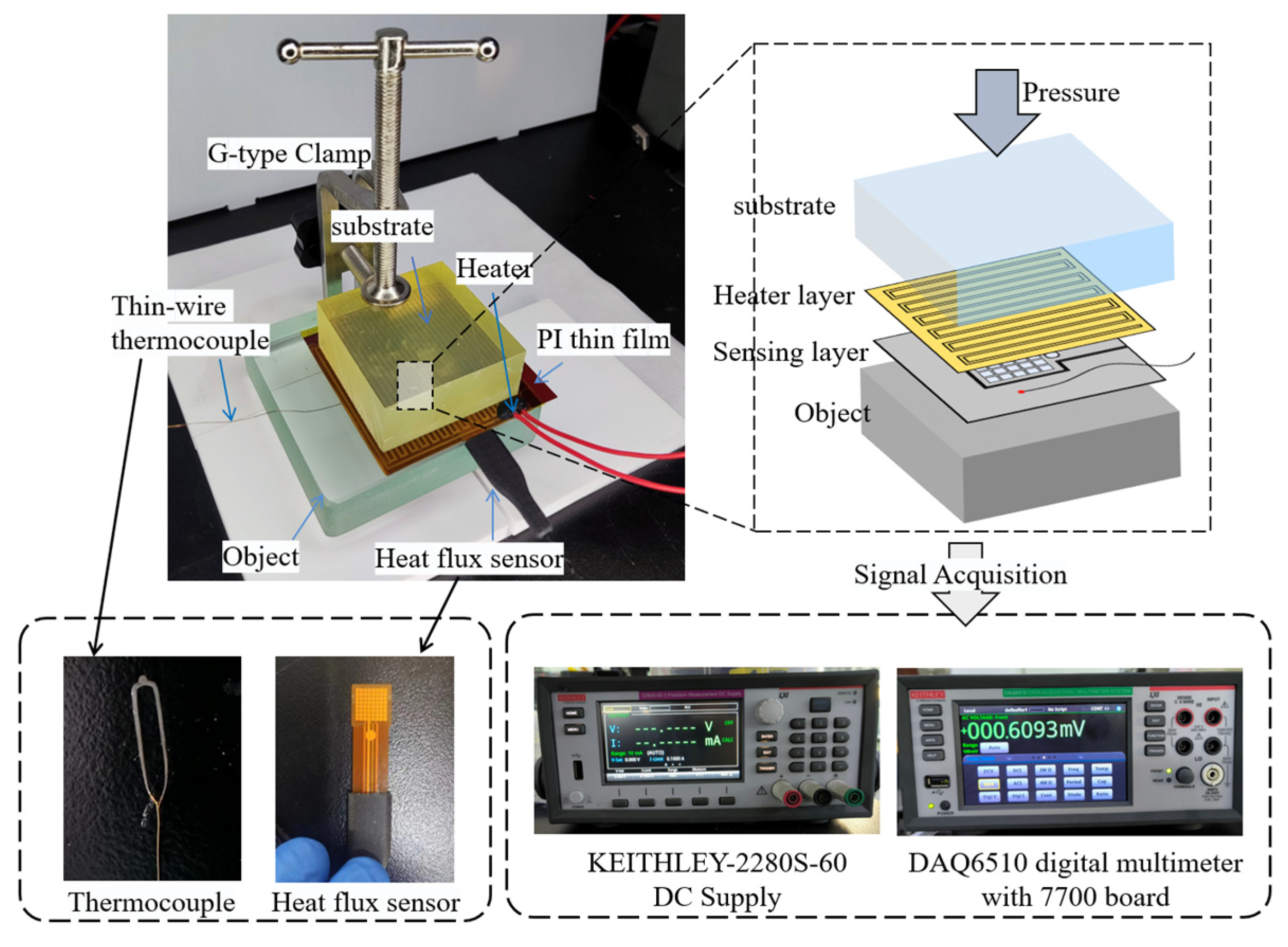
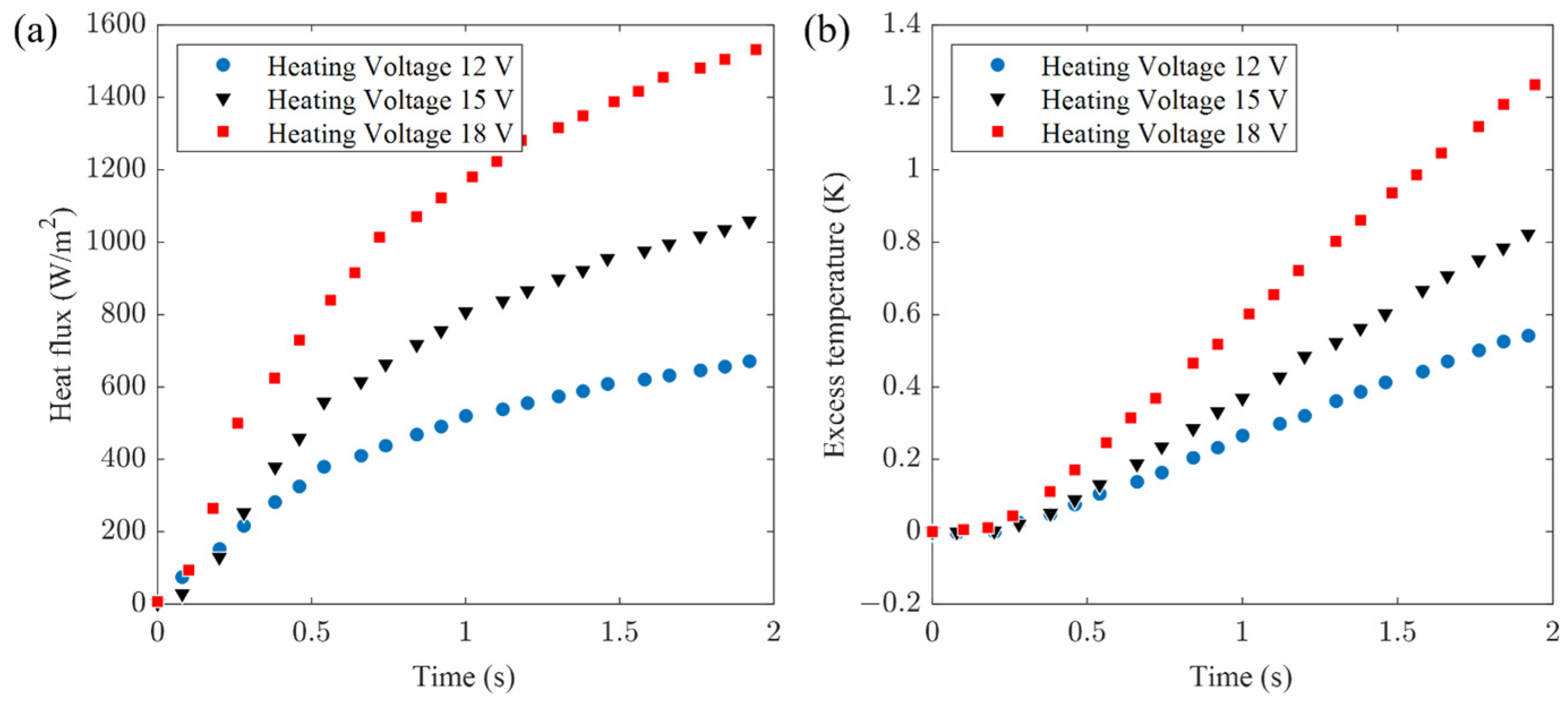

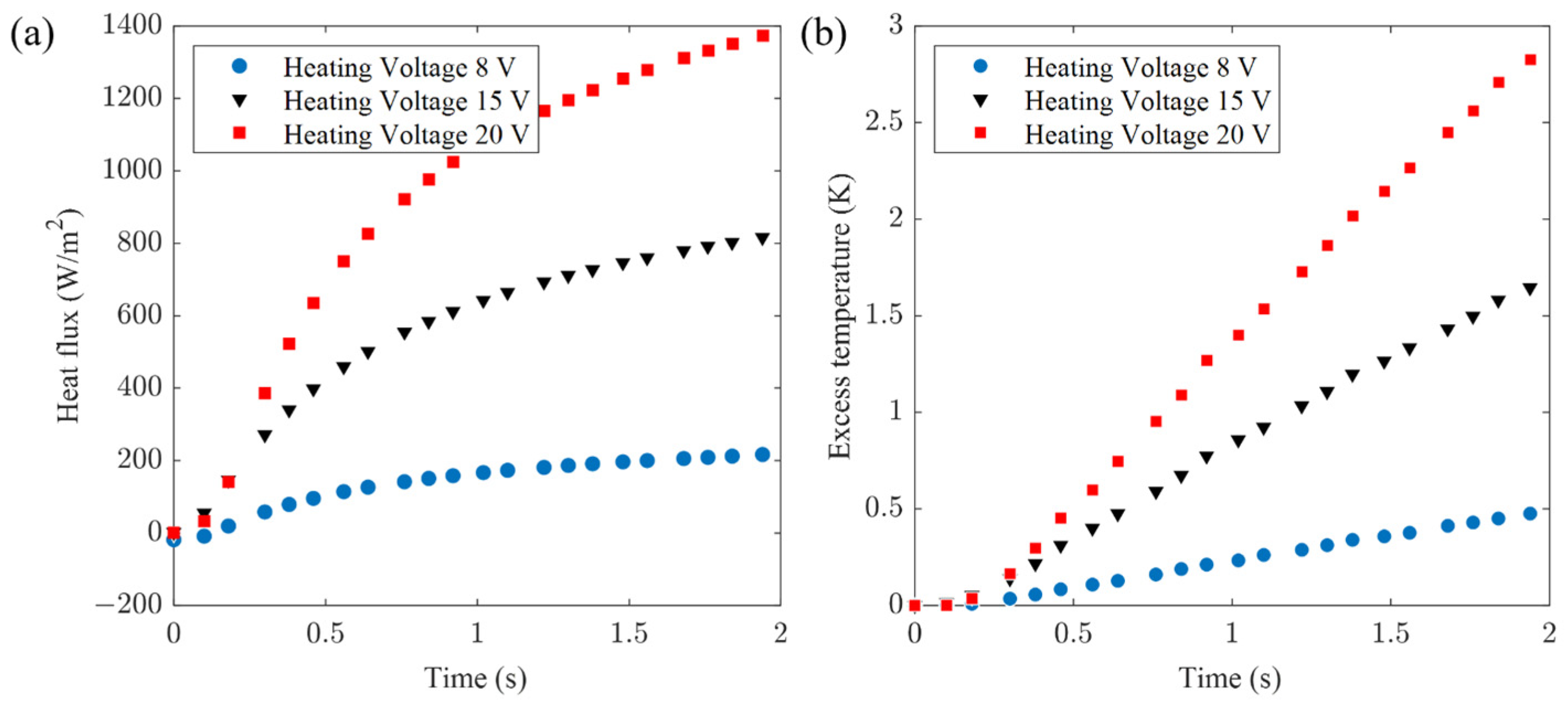

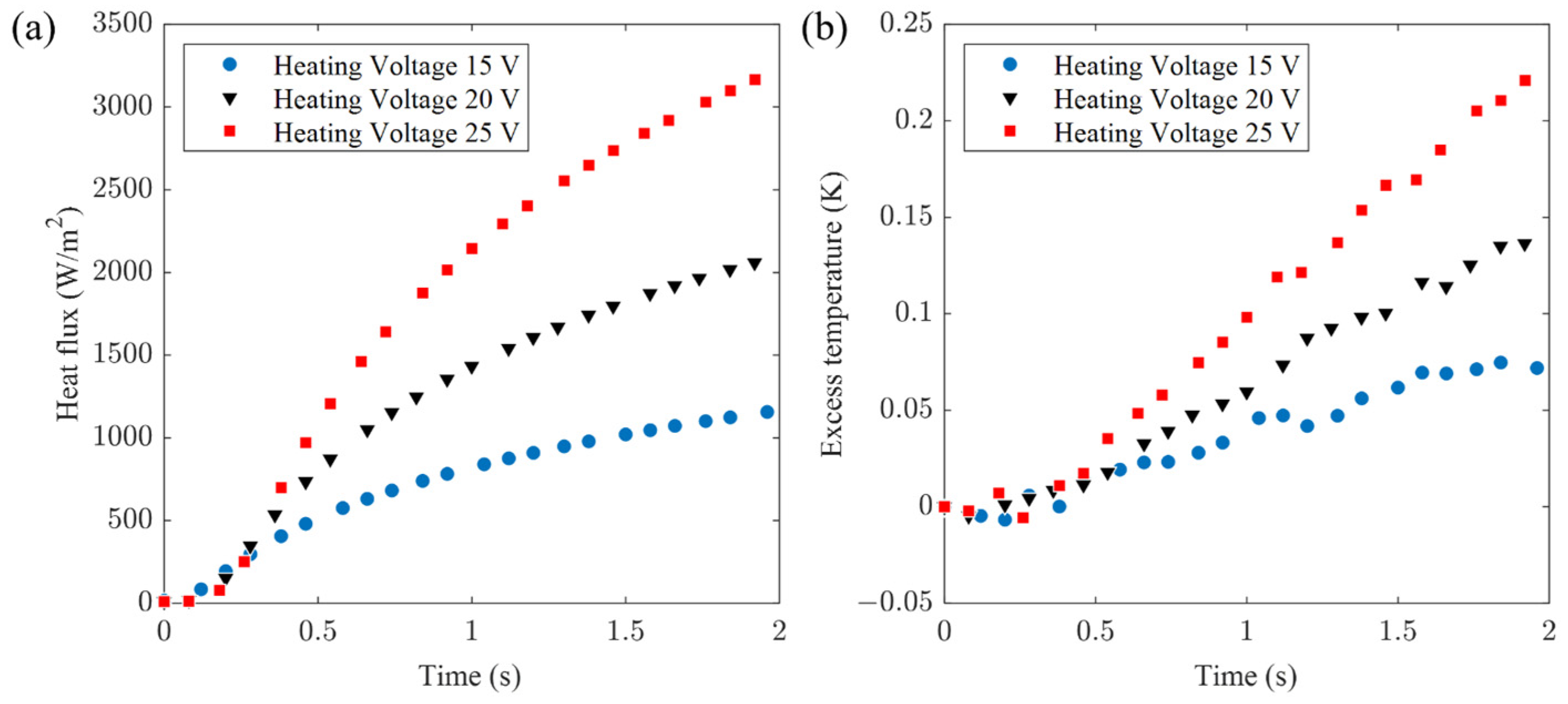
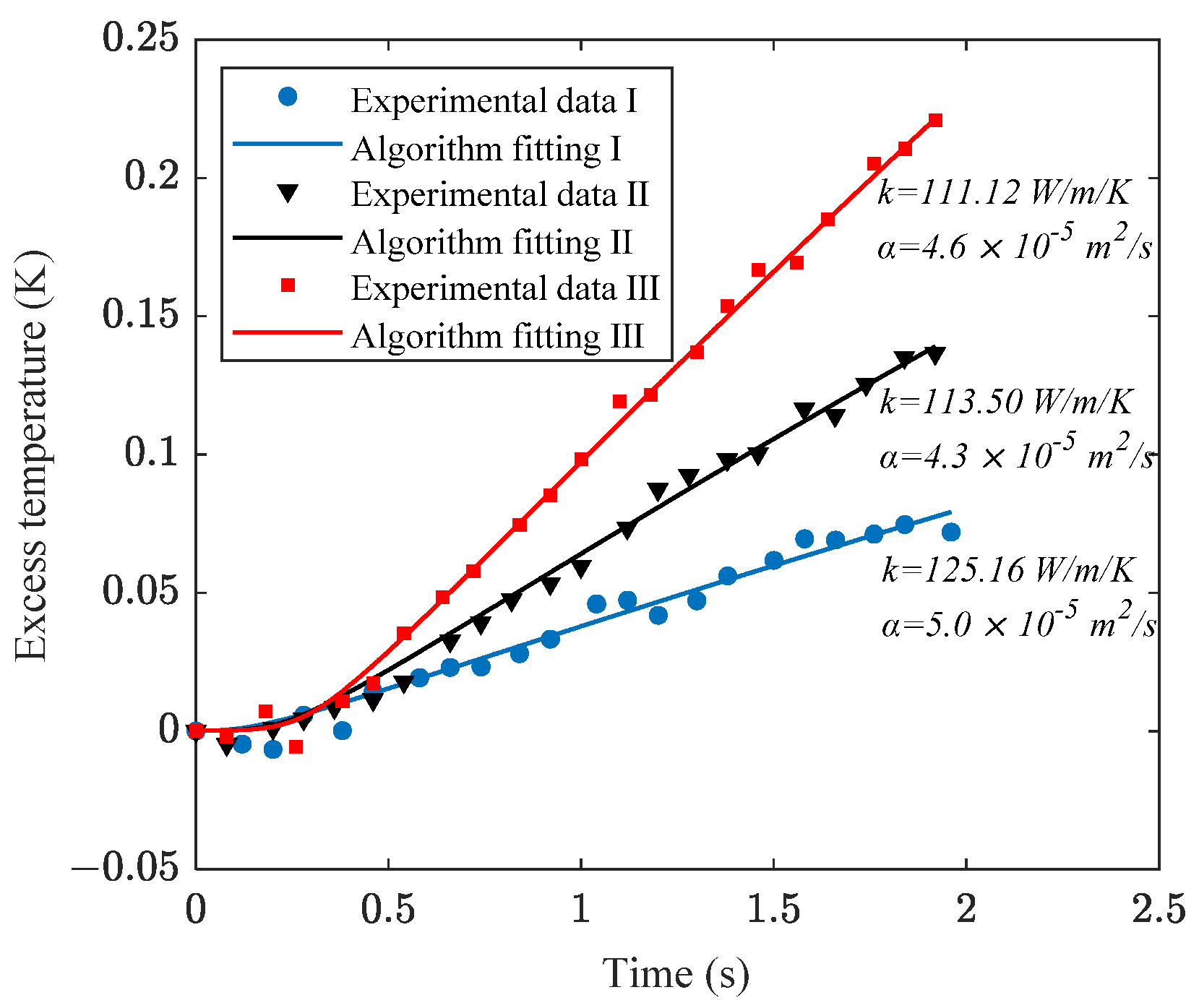
| Object | Thermal Conductivity/W∙m−1∙k−1 | Density/kg/m3 | Thermal Capacity /J/kg/K |
|---|---|---|---|
| Heating layer and sensing layer | 0.214 | 1951.6 | 1064.6 |
| Material I | 0.1 | 500.2 | 2400 |
| Material II | 1.5 | 2659.6 | 800 |
| Material III | 12 | 7860 | 477.1 |
| Materials | Thermal Diffusivity /mm2∙s−1 | Standard Deviation | Heat Capacity /J∙g−1∙K−1 | Standard Deviation | Density /kg∙m−3 | Standard Deviation |
|---|---|---|---|---|---|---|
| Tempered Glass | 0.552 | 0.00350 | 0.809 | 0.0012 | 2458.4 | 5.798 |
| PMMA | 0.110 | 8.17 × 10−4 | 1.429 | 0.0029 | 1178.35 | 1.344 |
| Aluminum Alloy | 51.9 | 0.22 | 0.873 | 6.03 × 10−4 | 2651.5 | 17.82 |
Disclaimer/Publisher’s Note: The statements, opinions and data contained in all publications are solely those of the individual author(s) and contributor(s) and not of MDPI and/or the editor(s). MDPI and/or the editor(s) disclaim responsibility for any injury to people or property resulting from any ideas, methods, instructions or products referred to in the content. |
© 2024 by the authors. Licensee MDPI, Basel, Switzerland. This article is an open access article distributed under the terms and conditions of the Creative Commons Attribution (CC BY) license (https://creativecommons.org/licenses/by/4.0/).
Share and Cite
Ma, T.; Zhang, M. Data-Driven Contact-Based Thermosensation for Enhanced Tactile Recognition. Sensors 2024, 24, 369. https://doi.org/10.3390/s24020369
Ma T, Zhang M. Data-Driven Contact-Based Thermosensation for Enhanced Tactile Recognition. Sensors. 2024; 24(2):369. https://doi.org/10.3390/s24020369
Chicago/Turabian StyleMa, Tiancheng, and Min Zhang. 2024. "Data-Driven Contact-Based Thermosensation for Enhanced Tactile Recognition" Sensors 24, no. 2: 369. https://doi.org/10.3390/s24020369
APA StyleMa, T., & Zhang, M. (2024). Data-Driven Contact-Based Thermosensation for Enhanced Tactile Recognition. Sensors, 24(2), 369. https://doi.org/10.3390/s24020369






